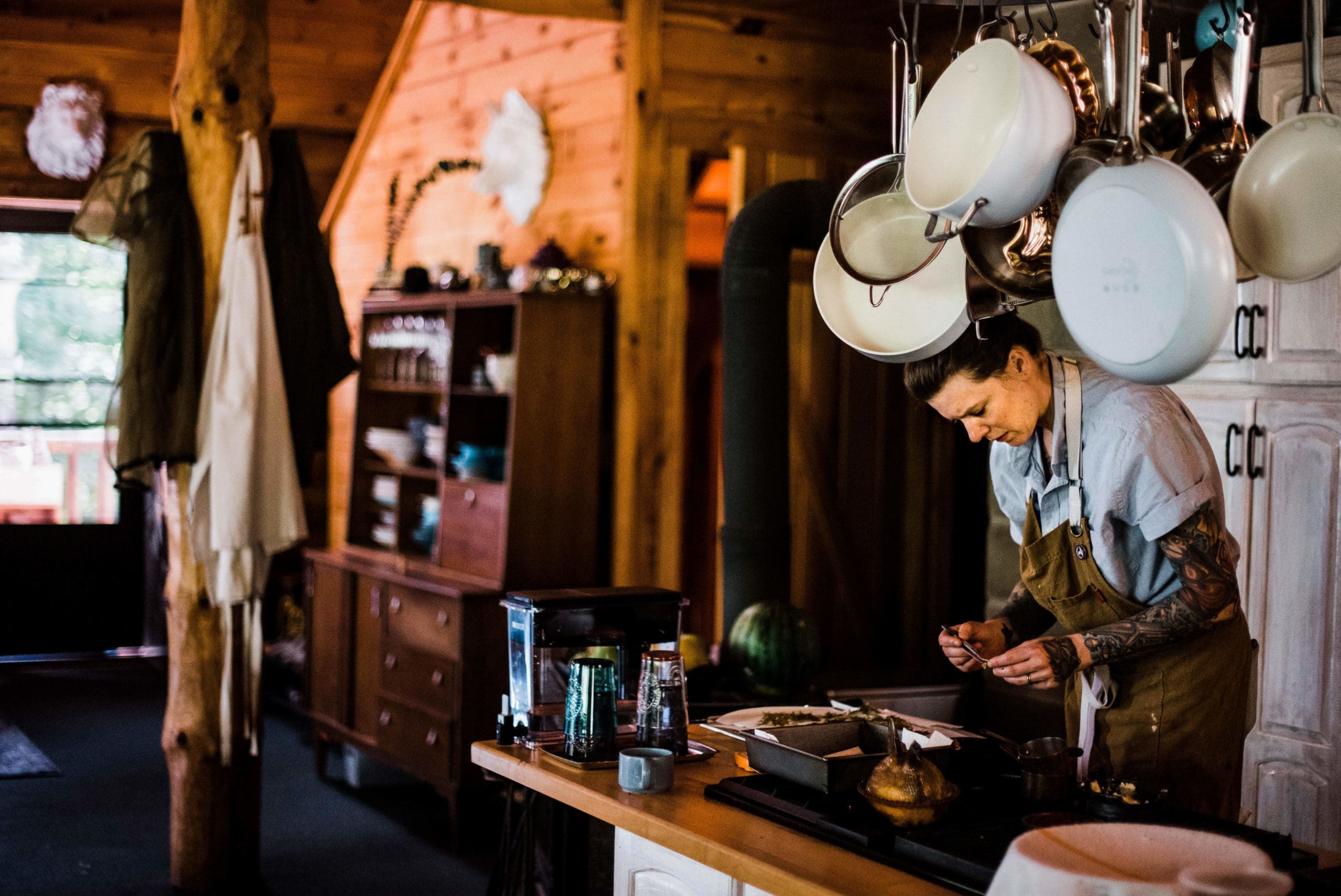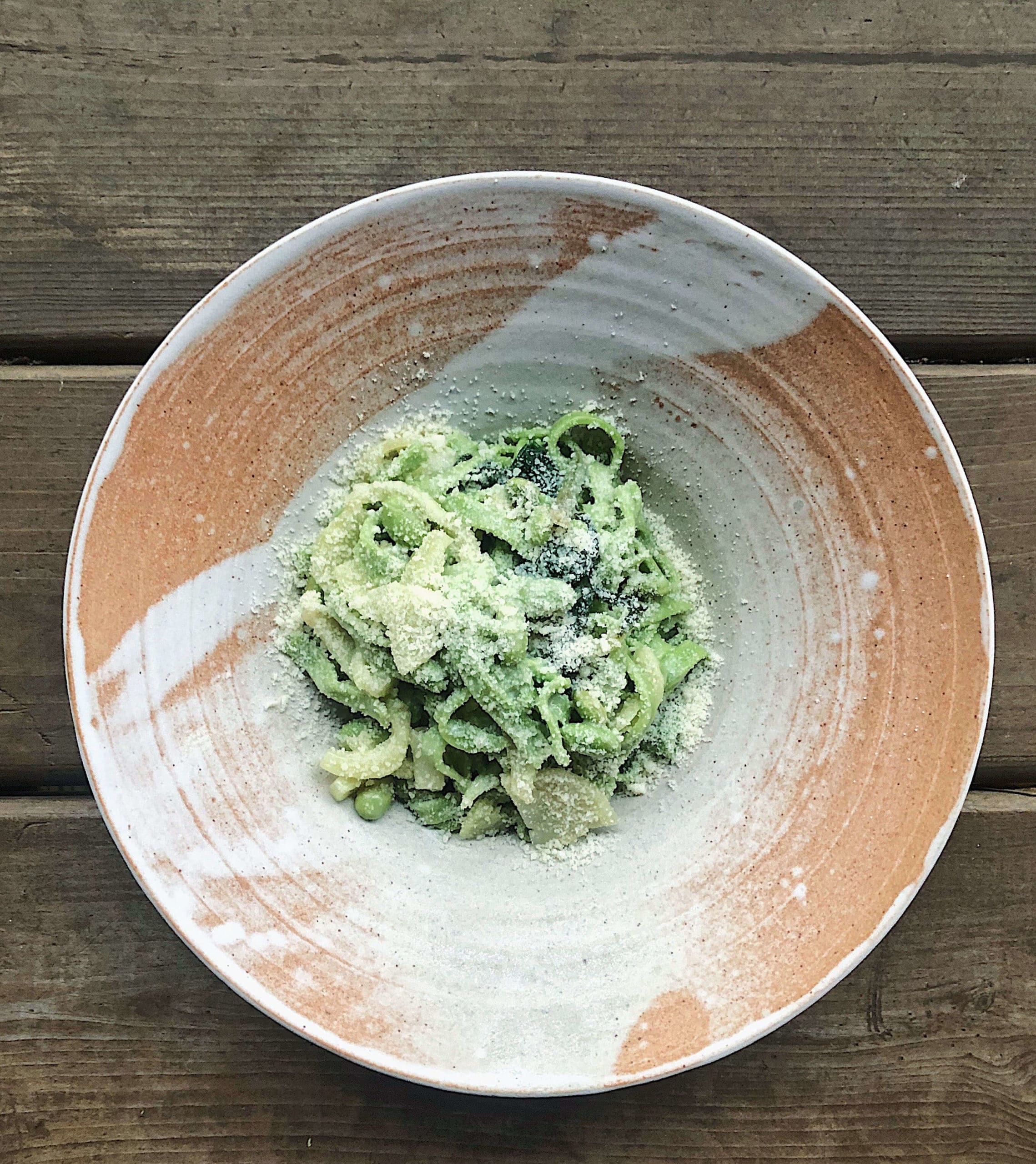Iliana Regan came from the woods, chasing chanterelles and trouble in rural Indiana before moving to Chicago and becoming one of its most celebrated young chefs at her Michelin-starred eatery, Elizabeth. So when she and her wife, Anna Hamlin, decided to trade the city for a remote nook of Michigan’s Hiawatha National Forest to open the culinary-focused Milkweed Inn in 2019, it felt like a homecoming of sorts. “I’ve always dreamed of having a bed and breakfast,” Regan explains, noting that her great grandmother ran an inn in Poland in the early 1900s. “Cooking and foraging in the woods is part of my family inheritance.”
Like a scheming cousin, the pandemic nearly stole that inheritance. When The New York Times ran a flattering profile of Milkweed in its January 22, 2020, edition, the front page carried with it an ominous message: As Infections Mount, Virus Poses Test for China: First U.S. Case Confirmed as Lunar New Year Travel Surges. “It was the first time COVID appeared on the front page of the Times,” Hamlin recalls.
With Hamlin immunocompromised and Regan’s mother undergoing chemotherapy, the couple was scared on a personal level. Professionally, they were disappointed. “We were finally doing something that felt really right for us, and the rug was pulled out,” Regan notes. Before Milkweed could kick off its first full — and fully booked — season, it had to go into hibernation like the bears with which it shares the woods.
The duo and their four dogs hunkered down. They planted a garden. Regan worked on the manuscript for her second book, a sequel to her fearsome memoir, Burn the Place. They foraged, but the forest was atypically bare. “It was like the flora and fauna were in quarantine, too,” Hamlin recalls.
Fortunately, both plants and wildlife emerged on schedule this spring. After pushing their reservations back a year and putting robust safety protocols in place, Milkweed welcomed visitors in May. The inn hosts 10 guests at a time for all-inclusive weekend getaways that include family-style Friday dinner, Saturday lunch cooked over live fire, a 15-course tasting menu on Saturday night, and sendoff Sunday brunch.
Regan, a four-time James Beard Award nominee, cooks what the forest provides: ramps and fiddleheads, chokecherries and dewberries, hazelnuts and oyster mushrooms, and countless other wild edibles. Hamlin pairs the wines, trucking in dry sherries and skin-contact whites from Elizabeth then supplementing with what she can find at the nearest wine shop, some 70 miles away in Marquette. And when each weekend is over, they hit the sheets. “I never thought I’d be ironing pillowcases in my life,” Hamlin laughs. “But they get wrinkly!”
In a way, Regan has been preparing for Milkweed her entire career. “There’s quite a lot of hospitality crossover between running a restaurant and a hotel,” she says. “When I started my business, I had an underground restaurant in my home that was very welcoming and really invited people into my life. Then when I opened Elizabeth, it was also very small and home-like. We have a long history of really getting to know our guests.” Many of those regulars have in turn become guests of the inn.
Which is why their absence felt so acute last year. “I get a lot of satisfaction out of gathering wild ingredients and creating menus, but being able to show people what’s growing right around us and having them experience that really heightens the cooking experience for me,” Regan shares. “I’m just very, very excited there will be a Milkweed this season. To have this back in my life is a beautiful feeling.”
Fresh Nettle Pasta with Kale Pesto
Makes 4 servings
This recipe is a mainstay from the pasta class Iliana Regan teaches at Elizabeth and during Milkweed Inn’s Wildcrafting Workshops. It calls for fresh greens (kale and nettles here), but the formula is flexible depending on what’s in season. Try ramps, beet greens, carrot tops, garlic scapes, herbs or a mixture.
MAKE AHEAD The pesto can be made up to three days in advance. Once it’s packed into a container, cover with a thin layer of olive oil to prevent browning.
Kale Pesto
1 bunch Tuscan kale, stemmed
1 cup extra virgin olive oil, plus more to serve
½ cup Parmesan, plus more to serve
¼ cup pepitas, cashews or walnuts
1 Tbsp. lemon zest
½ garlic clove
kosher salt to taste
Fresh Nettle Pasta
2 packed cups 00 flour
1 tsp. kosher salt
19 egg yolks, preferably from pasture-raised chickens
5½ cups nettle leaves, stemmed, blanched and drained
1½ tsps. extra virgin olive oil
1. For the pesto: In a food processor, combine ingredients and pulse, adding more oil as needed, until well combined. Season with salt to taste and reserve.
2. For the pasta: On a clean work surface, pile flour in a small mound. Make a well in center of flour and sprinkle over salt.
3. In a blender, pulse egg yolks, nettles and oil until smooth. Add to flour well.
4. Using a fork, gently whisk wet ingredients to introduce flour from sides of well, working slowly until dry ingredients are incorporated. Use a spray bottle of water to help bring dough together into a ball.
5. Knead dough 10 minutes, until firm, bouncy and smooth. Wrap in plastic and let rest at room temperature 1 hour.
6. Split dough into 4 sections. Working a piece at a time, flatten with a rolling pin to fit through widest setting of a pasta roller. Run dough through twice, decrease to next setting and run through twice more. Fold dough in half, place pasta roller back on widest setting and repeat. Fold again and repeat. Continue this process to achieve your desired thickness. Repeat for rest of dough.
7. Lay out pasta sheets. Using a knife or pasta cutter, cut ¼ inch thick for fettuccine or 1 inch thick for pappardelle.
8. To cook, bring a large pot of water to a rolling boil and generously salt. Add pasta and cook 2 to 3 minutes.
9. Strain pasta, return to pot and toss with pesto to combine. Transfer to a platter and garnish with oil and Parmesan before serving.






